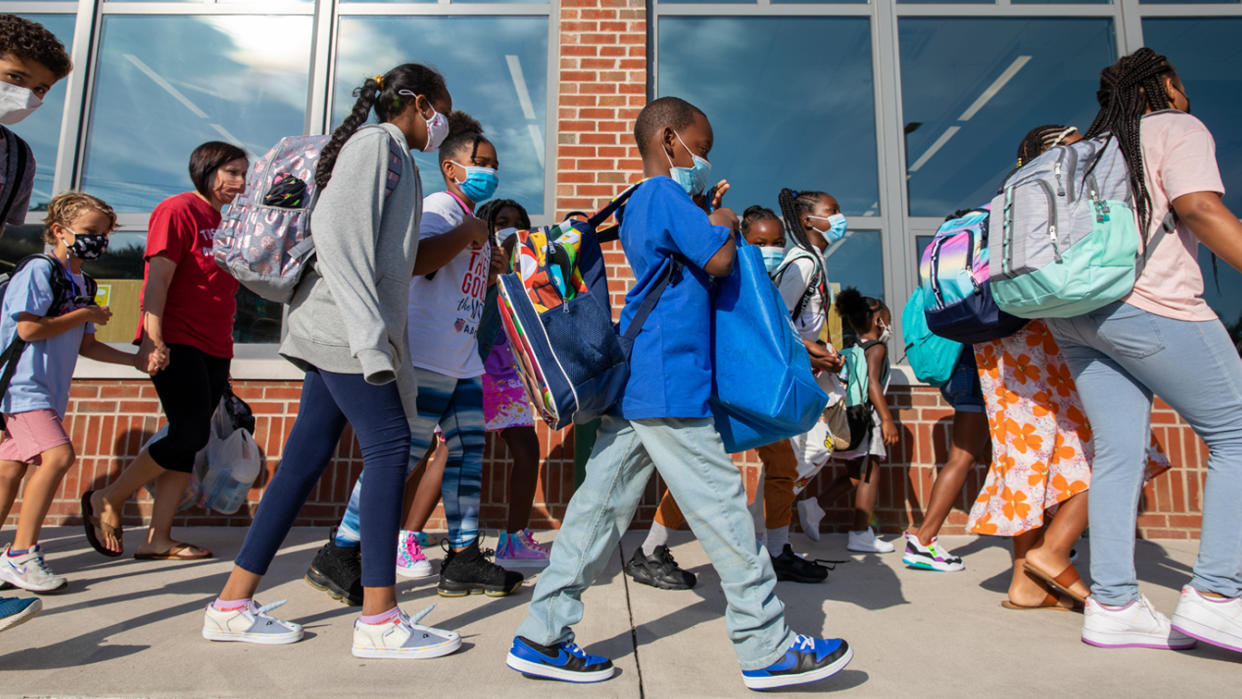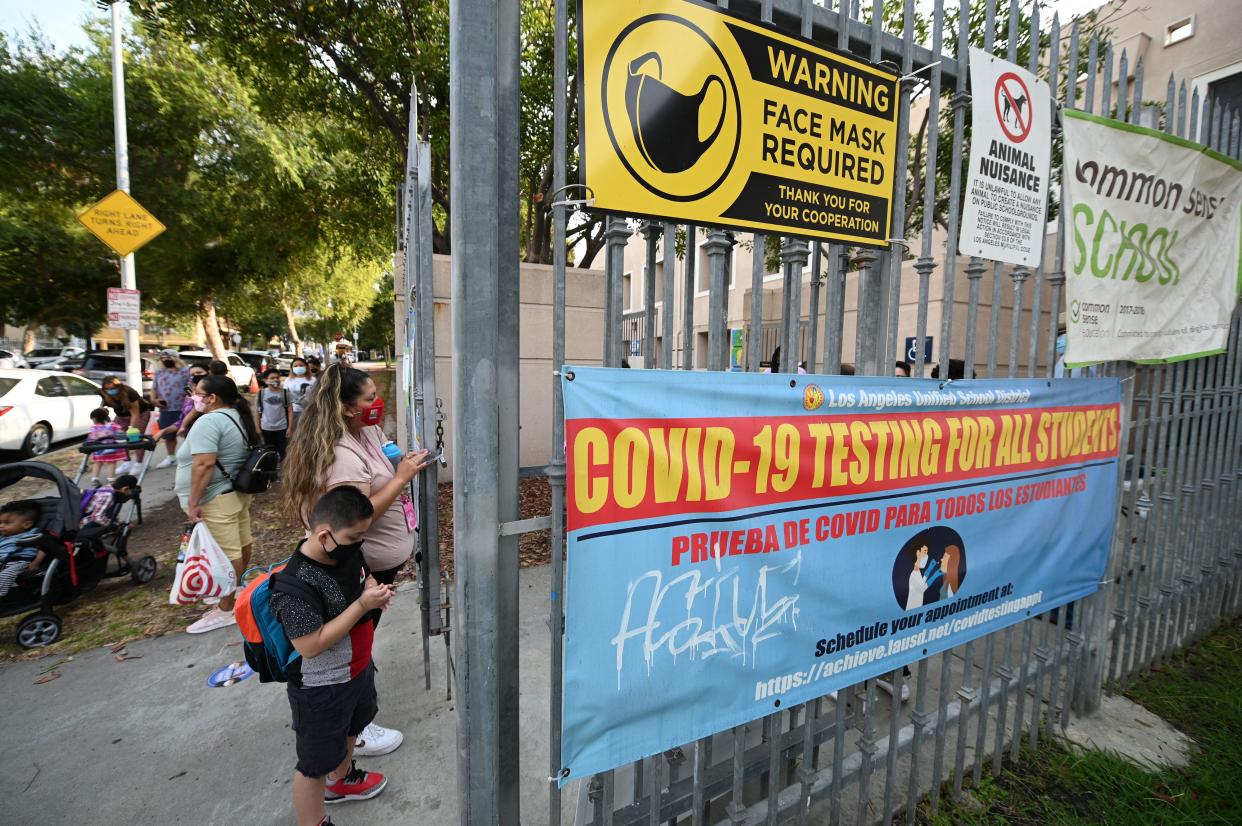Are blue states finally getting schools right?
WASHINGTON — One year after many Republican-led states opened schools successfully for in-person instruction, Democratic-led states appear to be doing the same — although under very different circumstances, and in a political climate that favors their approach.
The crucial change can be summarized in a single word: Delta. The more transmissible variant of the coronavirus arrived in the middle of summer vacation, leading the Centers for Disease Control and Prevention to recommend masks in schools, a reversal of its earlier guidance.

Red states had safely conducted school for much of the 2020-21 school year without statewide mask mandates and figured they could do so again, failing to account for just how much more rapidly the new version of the virus would spread. Some of those states started banning masks in schools as early as May, in keeping with a widespread belief that the pandemic was coming to an end.
Blue states had been cautious, overly so according to critics. The advent of the Delta variant seemed to justify that caution — not to close schools, as those states had done in 2020, but to keep schools open. Those states reasserted their commitment to masking in late July and early August, after a CDC study based on an outbreak in Provincetown, Mass., made clear that the Delta variant spread quickly from person to person, even if it did not necessarily make people sicker.
The reversal underscores how much has changed since schools first closed for the coronavirus pandemic in March 2020. Since then, there’s been widespread agreement that remote learning doesn’t work well and students need to be in classrooms for educational, cognitive and emotional reasons. But just how to reopen schools, especially in the midst of an unexpected new surge fueled by the Delta variant, remains a point of fierce contention, as battles over masking in schools continue in several states.

So far, evidence strongly suggests that the more cautious states where Democrats tend to exercise political control are now better equipped to reopen schools, even if they were hesitant to do so when Donald Trump was president. States under Republican control where masks have been either prohibited or discouraged are being forced to close schools as infection rates spike and thousands of students enter quarantine.
Lower vaccination rates in those states are making that spike more pronounced than it might be otherwise.
“Some school districts have excellent precautions in place, including ones that go above and beyond what the CDC recommends,” says Dr. Leana Wen, the former Baltimore health commissioner and a visiting professor of emergency medicine at George Washington University. “Others are the opposite. I really worry about the children, their families and communities.”
According to the statistics firm Burbio, which tracks pandemic school trends, of the 700 schools in 158 districts that have already closed this year over COVID concerns, the overwhelming majority are in states like Florida, Texas, Kentucky, Tennessee and Georgia.
That could be partly a function of timing. Schools tend to begin later in the Northeast, with New York City — the country’s largest school district — returning kids to classrooms on Sept. 13.

Yet timing alone can’t fully account for the discrepancy. Burbio president Dennis Roche pointed to California, where schools reopened throughout August for in-person instruction. “We’ve seen very few closures,” Roche told Yahoo News. “California has gotten off to a steady start.” He said he was aware of only a handful of districts across the state that have reverted to remote instruction, out of 1,037.
A key may be the state’s mask mandate, which requires all students and staff in California schools to wear masks in schools. Gov. Gavin Newsom also mandated that teachers be vaccinated last month. Some districts have gone even further. In Los Angeles, all children and adults in schools are tested weekly for the coronavirus. Many other districts also conduct surveillance testing, albeit less pervasively.
“Districts that were heavily virtual and hybrid almost all of last year seem to have identified a road map to get open and to stay open,” Roche says. That includes reducing the spacing between students in classrooms, which allows for those classrooms to return to full capacity (an earlier insistence on 6 feet of spacing made that impossible). To compensate for the decreased distance, most of these districts require masks indoors. And they are conducting intermittent testing in schools to catch the warning signs of a surge.
These measures may be considered onerous by some but are widely recognized as necessary to keep schools open. “The will to keep schools open has changed from 2020 to 2021, despite the rise of the Delta variant,” Dr. Monica Gandhi, an infectious disease specialist at the University of California, San Francisco, wrote in an email to Yahoo News. “The ill effects of school closures (including mental health and learning loss) are now clear.”

San Francisco schools stayed closed for virtually all of last school year, infuriating parents who watched as the city’s school board became an object of ridicule for vowing to rename schools honoring Abraham Lincoln and George Washington instead of crafting a reopening plan. The school’s name remained, the board members are facing a recall and San Francisco schools are finally open, thus far without a major hitch.
Meanwhile, schools are closing across the Midwest and Southeast, reverting to remote learning. In one Florida district, thousands of students had to quarantine after exposure to the coronavirus. Many rural districts across Texas have had to close, with the coronavirus exploiting low vaccination rates in parts of the state.
According to the CDC, if students are masked, fewer of them have to be quarantined at home in case there is a positive case in the classroom. But in schools where masks aren’t mandatory, the circle of close contacts potentially requiring quarantine grows much larger, thus leading to precisely the kinds of disruptions in learning that governors had promised to prevent.
Burbio’s Roche says the continuing battle over masking in Republican-led states has made for a noisier reality around quarantines than in Democratic-led ones, which have been early and consistent with mask mandates. He points to Indiana, where no mask mandate was in place when the school year began. There was a sharp spike in coronavirus cases in late August, with 6,000 cases reported in schools across the state in the final week of the month. Now some districts are requiring masks, after having previously made them optional.
"I realized that if we had all of our children in masks," an Indiana school official explained, "I can quarantine fewer children.”

Nearly 7,000 students are now in quarantine across Horry County, S.C., where Republican governor Henry McMaster spent the summer resisting a new mask mandate. “I would love for a mask mandate to take place tomorrow," one seventh grader told a local news outlet. “Right now.”
“That's not a great formula for keeping schools open,” Roche says. Burbio has found that of the country's 200 largest districts, 140 now have mask mandates, up from 103 in mid-August.
Keeping schools open was a challenge for Trump, who pushed for a fall reopening throughout the summer of 2020 but did little to actually gain the trust of educators and elected leaders critical for that effort to succeed. The mere fact that the immensely polarizing president was advocating for schools to reopen convinced some that it was unsafe to do so, even if the science suggested otherwise.
Ron DeSantis, the young and ambitious Florida governor, rose in national prominence in part by bucking the teachers' unions and mandating that schools open. They did so safely — with varying degrees of masking— even as schools in New York, California and Illinois stayed closed well into 2021. In part because he made reopening schools a priority, DeSantis was celebrated in the national media and began garnering support for a potential 2024 presidential run.
Biden made reopening schools a priority when he became president in January 2021, even though his closeness with the teachers' unions made some skeptical. The coronavirus relief package included $130 billion for schools. Those funds were to be used to improve ventilation, hire more teachers and make other adjustments that educators had been clamoring for. Administration officials were not especially subtle in reminding educators that in exchange for those funds, they wanted to see children in classrooms again. School closings threatened to become not just an educational and social crisis but also a political one for Democrats.

Even recalcitrant districts in the West and Northeast got the message. In mid-April, the share of American students attending school fully online fell below 10 percent for the first time since the pandemic began. And the same unions that had resisted reopening now pushed for their members to get the newly available coronavirus vaccine. By the end of the school year, nearly all American teachers were vaccinated.
In late summer, though, resistance was emerging from another, unexpected area. As schools prepared to open in Florida, DeSantis said that districts could not impose mask mandates, no matter how much viral spread the surrounding community was experiencing. By then, there was ample evidence that the Delta variant necessitated new precautions because of its transmissibility, but DeSantis was determined on running the same playbook he had in 2020, only with a harder edge.
While he had never seriously encouraged masking, DeSantis now actively discouraged it, in keeping with some conservative arguments that masking children was a form of abuse (most children seem to be fine with mask wearing, studies have shown). “You’re free to recommend, you can encourage whatever you want,” DeSantis said in early August.
School districts said they would not abide by the governor’s orders, and the Biden administration joined the fray, telling educators it would support them if they resisted DeSantis's mask mandate ban in schools. As a result, millions of children across Florida are now going to school in masks, even as DeSantis continues a fight most of his own constituents do not support.

DeSantis has been the most prominent opponent of masking but is far from the only governor to have taken up that cause. On Monday, the U.S. Department of Education said it was suing five of those states — Utah, Tennessee, South Carolina, Oklahoma and Iowa — for violating students’ civil rights by saying that schools could not mandate masking. Texas, Florida, Arkansas and Arizona are not part of the suit because legal challenges there have prevented the mask ban from going into effect.
Gov. Asa Hutchinson of Arkansas became an unlikely ally of President Biden last month when he said he regretted signing such a ban into place. He moved to have the Legislature strike it down, only to have a judge do so first. The outcome pleased the conservative governor, who believes the masking culture wars are a distraction and masks themselves hardly the menace portrayed by DeSantis and others.
“The kids adjust to it,” Hutchinson told Yahoo News. “They want to get educated.”
____
Read more from Yahoo News:



